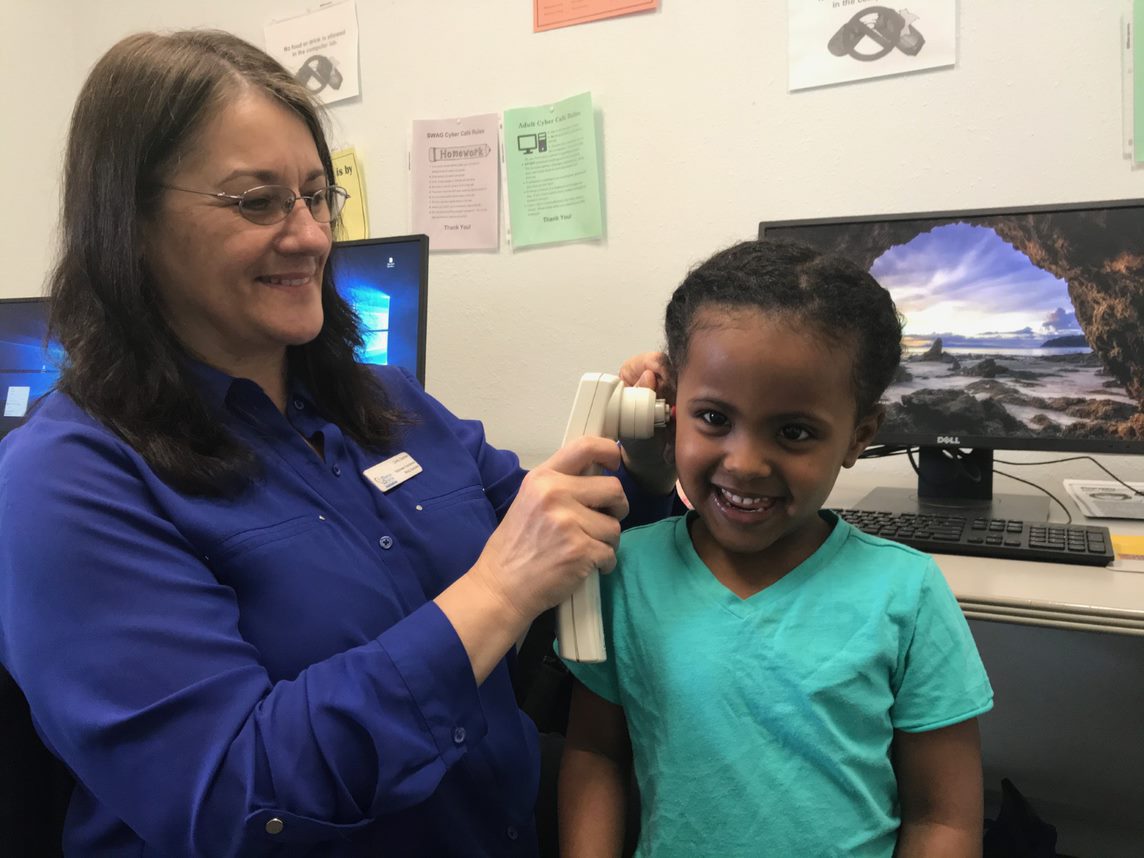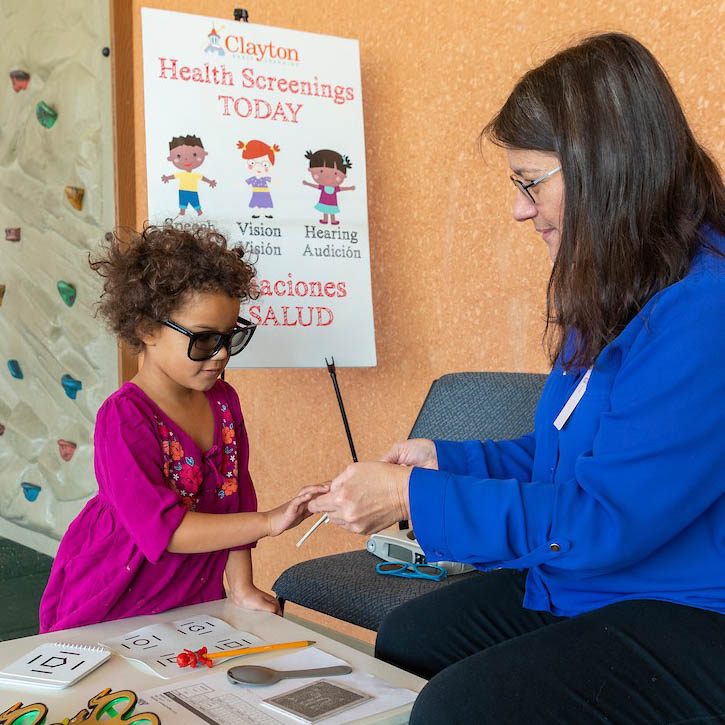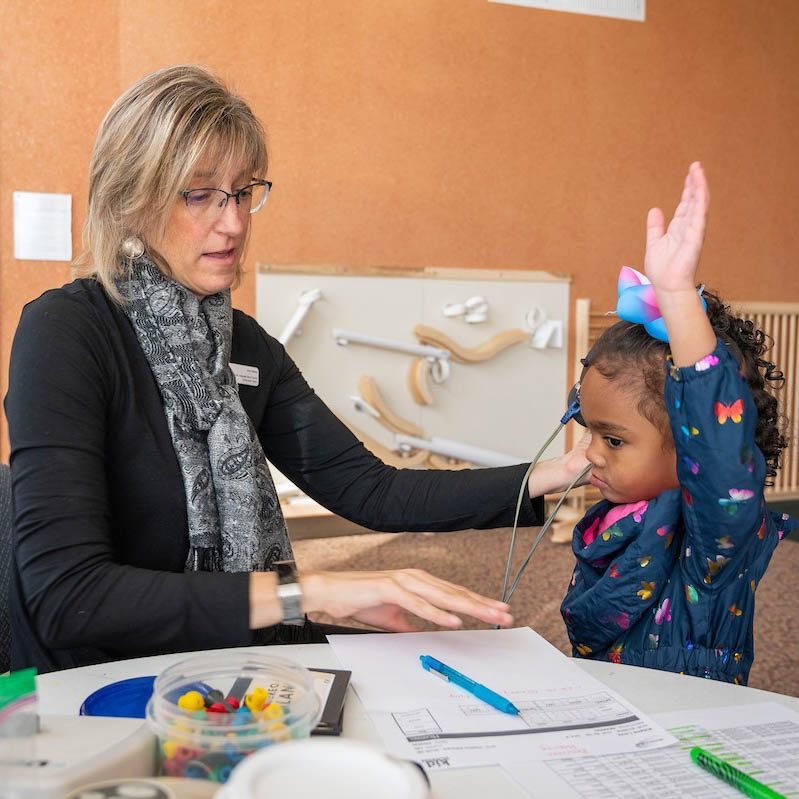Overview
KidScreen is a hearing, vision, and speech/language screening program offered by the Marion Downs Center to promote early identification of communication and learning problems. Most doctors’ offices do not offer comprehensive screening for hearing, speech and functional vision at well child checkups.
KidScreen is a low-cost means to provide vital screenings to children across the city, including at a number of Early Head Start and Head Start sites, as well as private preschools, childcare sites, private schools and charter schools. We provide on-site screening services.
To learn more about our services, contact us using the form below.

Early detection and management of hearing problems can significantly improve a child's ability to learn. There can be several reasons for a failed hearing screen, such as inattention, fatigue, misunderstood directions, presences of middle ear fluid, excess ear wax, or a hearing loss.
OTOACOUSTIC EMISSIONS (OAEs)
This is an automatic test that does not require a response from your child. It is a test of the function of the inner ear or cochlea. A small probe is placed in your child’s ear. The tip directs sounds into the ear canal and records the responses of the cochlea. This test detects sensorineural hearing loss. Although this test sometimes misses very mild hearing loss or unusual types of hearing loss, it does identify most childhood hearing problems. (Ages 6 months-18 years)
PURE TONE AUDIOMETRY
This is a hearing test in which headphones are placed over your child’s ears. He/she is asked to respond when a sound is heard through the headphones. While we will try to complete pure-tone testing for children age 4 and above, there are a variety of reasons why we may not get completely accurate screening results. In those cases, we will use Otoacoustic Emissions testing. (Ages 4-18 years)
TYMPANOMETRY
This screening is performed if a child does not pass the hearing screening. This automatic instrument changes pressure in the ear canal and measures eardrum movement. The test does not cause any discomfort and is helpful in identifying children with middle ear fluid and/or possible infection. (Ages 6 months-18 years)
Understanding Your Child’s Screening Report
Pass: Results of the hearing screen indicate age appropriate responses.
Refer:
Private Preschool:
Refer to a primary care provider for referral (as needed) or refer directly to Marion Downs Center or a pediatric audiologist of your choice for a diagnostic evaluation of hearing.
Or if the child's middle ear health/tympanometry may have affected hearing then: Refer to primary care provider for middle ear health evaluation and then follow up with audiologist of your choice or Marion Downs Center for further evaluation of hearing, once medically cleared.
Early Head Start or Head Start program:
Consult your school’s health staff for information regarding a hearing evaluation.
If your child is enrolled in an Early Head Start or Head Start program, a rescreening will be scheduled by your school’s health staff within 45 days.
Rescreen - Call Marion Downs Center at 303-322-1871 to schedule a rescreen.

Early detection and correction of vision problems can significantly improve a child's school readiness and ability to learn. There are several ways we check vision, including tests for visual acuity and for functional vision.
ABC CHECK
The ABC Checklist is a general check for possible vision concerns. This check includes inspections of appearance, behavior, and concerns (A,B,C). (Ages 6 months-18 years)
AUTOREFRACTOR
Objective, automated instrument that analyzes light reflected from the retina to give an estimate of refractive error. Certain significant refractive errors indicate risk factors for amblyopia (lazy eye); strabismus (misalignment of eyes); nearsightedness, farsightedness and astigmatism. The autorefractor test is not performed on children ages 7, 8, and 9 because of changes in eye development in that age range. (Ages 6 months-18 years)
SPOT VISION SCREENER
Handheld vision screening device that detects vision issues on patients from 6 months through adult age.
DISTANCE VISION ACUITY
This test measures the ability to see shapes or letters at a distance. Vision acuity may pass based on autorefractor results, distance acuity, or both. (Ages 3-18 years)
FUNCTIONAL VISION
Functional vision is assessed in children aged 6 months to less than 6 years by three tests of eye movement: Tracking, Near Point Convergence, and Alternate Cover. Tracking is the ability to follow a moving object smoothly and accurately with both eyes. Near Point Convergence is the ability of both eyes to focus on objects at near range. The Alternate Cover test is used to detect potential misalignment of the eyes, or strabismus. (Ages 6 months-6 years)
STEREO DEPTH
Binocularity or the ability to use both eyes together and perceive depth (Ages 3-6 years)
PLUS LENS
Detection of greater than normal amounts of farsightedness (Ages 6 years and older)
Understanding Your Child’s Screening Report
Pass - Results of the vision screen indicate age appropriate responses.
Refer - Results of the vision screen indicate that responses did not meet passing criteria. Refer to your primary care provider (PCP) or pediatric vision doctor for a comprehensive eye exam. If your child is in an Early Head Start or Head Start Program: Consult your school’s health staff for information regarding a vision evaluation.
Children with prescription eyeglasses should have a comprehensive eye exam annually or sooner, depending on your eye doctor.
Rescreen - Early Head Start or Head Start Program: a rescreen will be scheduled by your school’s health staff within 45 days.

Early detection and intervention of speech and language problems can significantly improve a child's ability to learn and to communicate.
For children less than 2 years, developmental milestones for speech and language are assessed by parent and/or caregiver questionnaire and by a series of observations at the time of screening.
Children aged 2 to 3 years are screened for age-appropriate emergence of speech sounds and gestures.
Children aged 3-7 years are screened for age-appropriate production of speech sounds.
Additionally, children are assessed for overall speech clarity/intelligibility in both formal and conversational speech production.
SPEECH/LANGUAGE MILESTONES
Typical speech/language milestones for children aged 7 months to less than 3 years.
SPEECH CLARITY
The ability to clearly understand the spoken language of the child. (Ages 7 months-18 years)
ARTICULATION
A child's speech articulation is tested for a variety of speech sounds against normative data at age appropriate levels. (Ages 2-18 years)
Understanding Your Child’s Screening Report
Pass - Results of the speech/language screen indicate that speech or language development appears to be age appropriate.
Refer - Refer to Marion Downs Center, Child Find, or a speech-language pathologist of your choice for a comprehensive speech and/or language evaluation. For an Early Head Start or Head Start program: Consult your school’s health for information regarding a speech and/or language evaluation.
Continue - Follow plan of care as already determined by your child's current speech-language pathologist.
Rescreen - Results of the speech screen indicate that some responses were inconsistent or could not be obtained for one or more required tests. Call Marion Downs Center at 303-322-1871 if you have questions, otherwise rescreen as recommended on your report.

Children learn skills important for reading and writing during early speech and language development. Our standardized language screening test is used to help determine if a child's language skills are developing normally or if he or she is in need of further assessment of language abilities.
PLS-5 Screening Test
The PLS-5 Screening Test (Preschool Language Scale - 5th Edition Screening Test) is used to identify children, from birth to age 7.11, who are at risk for a language disorder or may need further assessment of language abilities. Speech and language development has been related to school success. This test is designed to be a first step in an assessment process but it can also be used to monitor children who have been dismissed from language therapy.
The PLS-5 Screening test is not designed to provide a diagnosis of speech or language disability, determine the degree of impairment of speech or language abilities, or to identify specific strengths or weaknesses. It is intended to differentiate a child who appears to be developing language skills normally from a child who needs in-depth assessment to determine if he or she has a language disorder. For KidScreen purposes, we prefer to use this test on children 3.0-7.11 years of age.
- At 3 years of age, the PLS-5 Screening Test assesses whether a child recognizes action in pictures (who is eating?), understands negatives in sentences (show me the box with no toys), can name a variety of pictures objects, uses plurals, and produces 4-5 word sentences.
- At 4 years of age, the PLS-5 Screening Test assesses whether a child understands sentences with further details or descriptions of nouns, (show me the black kitten), understands pronouns, tells how an object is used (what do you do with a pencil), uses possessives, and answers questions about problem-solving situations.
- At 5 years of age, the PLS-5 Screening Test assesses whether a child can point to letters, understands complex sentences, uses possessive pronouns, formulates meaningful, grammatically correct questions, uses phrases to describe nouns/objects, and names categories.
- At 6 years of age, the PLS-5 Screening Test assesses whether a child understands quantitative concepts, identifies a picture that does not belong, identifies words that rhyme, can give a reason when asked a ‘why’ question, repairs sentences that do not make sense, and repeats increasingly complex sentences.
- At 7 years of age, the PLS-5 Screening test looks to see if a child understands prefixes, identifies a word that does not belong in a category, formulates sentences when given specific words, uses synonyms, and uses irregular plurals.
CELF-5 Screening Test
The CELF-5 (Clinical Evaluation of Language Fundamentals-5th Edition Screening Test) is a research-based, individually administered clinical tool designed to screen students, ages 5 years 0 months through 21 years 11 months, for language disorders. This test is designed to assist in identifying individuals who may need further assessment of their language abilities, and screens a child’s skills in morphology (word structure rules), syntax (grammar) and semantics (word meaning), using age appropriate test items.
Ages 5-8
Word Structure: the child is shown pictures and prompted to answer questions that screen his/her knowledge of rules for extending word meaning (e.g., verb + ing).
Word Classes: the child is shown pictures and prompted to answer questions that screen his/her knowledge of semantics and relationships between words (e.g., "which one does not belong?").
Ages 5-21
Following directions: the student is shown pictures and given verbal directions to screen short term memory and sequencing skills (e.g., "point to the first [ _ ] after you point to the [ _ ].").
Recalling sentences: the student is asked to repeat sentences of increasing length and complexity to screen short term memory of meaning, word structure, and sentence structure.
Ages 9-21
Sentence Assembly: the student is asked to produce grammatically correct and semantically correct sentences when shown different words or word groups.
Semantic Relationships: the student is asked to choose correct answers from word problems that are read aloud to screen vocabulary, morphology, and syntax.
Word Classes: the student is asked to identify related words and the nature of the relationships between sets of words that are read aloud to screen for word categorization and semantics.
Understanding Your Child’s Screening Report
Pass - Results of the language screening indicate that language development appears to be age appropriate.
Refer - Results of the language screening indicate that responses for one or more tests did not meet screening criteria. Refer to Marion Downs Center, Child Find, or a speech-language pathologist of your choice for a complete evaluation.
Rescreen - Results indicate that responses could not be obtained for one or more required tests to complete the language screening. Call Marion Downs Center at 303-322-1871 to discuss these results.

Our developmental screening tests are based on your child's age. They help determine if your child's developmental, academic and learning skills are on target for his or her age, or if there is a need for further evaluation.
BAYLEY SCALES OF INFANT DEVELOPMENT
The Bayley Scales of Infant Development is a screening test that uses a variety of materials to screen the cognitive, language and motor functioning of infants and young children between the ages of 1 month and 42 months. The purpose is to quickly determine whether a child is progressing according to normal expectations and to determine if further, more comprehensive evaluation is needed.
SPEED DIAL-4
The Speed DIAL-4 (The Developmental Indicators for the Assessment of Learning-4th edition) is a developmental screening test is designed to identify young children aged 2y6m (2.5 years) to under 6 years in need of interventions or further evaluation. The Speed DIAL-4 provides information about a child’s developmental skills such as how the child uses his/her body (motor skills), knowledge of basic concepts like counting and colors (conceptual skills) and the child’s use of language.
Motor skills are related to cognitive development and the ability to perform a number of early-learning tasks. Concepts are the building blocks of knowledge that allow children to organize and categorize information. 1:1 correspondence, counting, classifying and measuring are the main concepts children use in everyday life. Understanding concepts is important to language and reasoning. Language is considered integral to emotional, social and cognitive development. Language is critical for learning across the curriculum.
The skills measured on the Speed DIAL-4 are proven to help predict a child’s success in the classroom. The results can help parents and teachers decide if a child’s skills are age appropriate or if further testing or interventions are needed.
WRAT-4
The WRAT-4 (Wide Range Achievement Test) is a screening tool used to measure the basic school skills needed for learning, communication, and thinking: reading and spelling words and completing basic math problems. Results of this test help determine whether a student should be referred for comprehensive testing.
Word Reading: assessment of whether a child knows the alphabet, the sounds letters make, and how to pronounce words.
Spelling: written assessment of basic word spelling skills.
Math computation: written or oral assessment of basic math concepts and skills.
Understanding Your Child’s Screening Report
Pass - Results of the development screening indicate that responses met screening criteria.
Refer - Results of the developmental screening indicate that responses for one or more tests did not meet screening criteria. Refer to Child Find
Refer - Results of the development screening indicate that responses for one or more tests did not meet screening criteria. Refer to Marion Downs Center to discuss these results and further recommendations.
Monitor - Results of the development screening indicate that some results may have been marginal at the screening criteria. Continue to monitor development, and call your primary care provider (PCP) or the Marion Downs center to discuss an evaluation if development does not progress or if you have further concerns.

The Marion Downs Center depends on volunteers to help keep our screening costs down.
KidScreen sites are spread throughout the Denver metro area. We typically are very busy in the fall and slower in the spring. Opportunities for a fall volunteer are available Monday-Thursday and likely some Fridays as well. Most screenings occur in the mornings, but we may have a few afternoon screenings as well.
Volunteer Expectations
- Available 1-2 days a week, mostly in mornings
- Complete a background check (cost will be covered by the Marion Downs Center)
Volunteer Duties
- Meet 15 minutes before start of screening to bring in equipment
- Set up screening equipment
- Administer hearing, vision, and speech screenings
- Data entry of screening results
- Monitoring flow of children and screenings
- Assisting with loading and carrying of KidScreen equipment
Contact KidScreen at kidscreen@mariondowns.org to inquire into volunteer opportunities.
